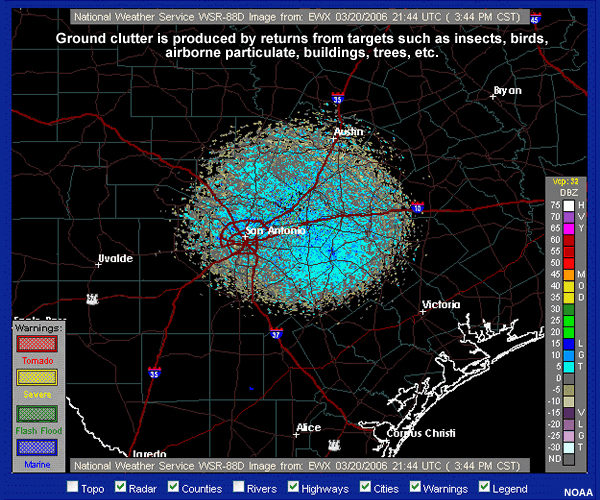Common Clear Air Phenomena » Non-Meteorological Returns » Biological Returns

Birds, bats, insects, and other airborne materials are often the only targets for radar pulses to intercept on clear days. Sometimes, they can produce their own unique signatures on radar. One of these is known as a "roost ring" or "bird burst." These are most easily diagnosed in a time series.
Birds often take flight near dawn, while bats leave their roosts near dusk (insects are also usually more active at night). Upon takeoff, these animals may quickly ascend several hundred feet as they spread across the area, forming a small ring that expands with time. Because most birds and bats fly relatively low to the ground, these types of echoes are generally only seen within about 30 nautical miles of the radar. Some larger birds, however, fly higher and may occasionally appear farther away.
Another way to distinguish whether what you're seeing is a mass of precipitation or some other kind of target is to look at its motion compared to the surroundings.
Question
Look at this loop of radar reflectivity.
Now use the pen tool to circle areas on the image below that might indicate radar echoes from non-meteorological targets, then click Done. You may ignore any potential biological targets within any "ground clutter."
| Tool: | Tool Size: | Color: |
|---|---|---|
|
|
In this loop, a small area of what looks to be light precipitation rises suddenly to the southwest of the radar. It then begins to move rapidly northwest, counter to the rest of the precipitation that is moving to the east or southeast. This rapid initiation and travel in a different direction from the surrounding precipitation are two good clues that you may be looking at biological targets.
If we also look at a base velocity image, we can see that initially, the biological targets diverge from a single point and over time, head a different direction.
To summarize, here are a few things to keep in mind about diagnosing biological targets on radar:
- Reflectivities are low, usually <15 dBZ, for small birds and bats.
- Often a small patch will move against winds and/or surrounding precipitation areas.
- An expanding ring may signal takeoff en masse.
- Take note of the time of day and season. Mass exit of roosting areas is typical at sunrise (birds) and sunset (bats, insects), and migration is most common in spring and fall. However, there are numerous exceptions.
- Birds typically cause wind speed errors of 19-29 kt (10-15 m s-1); large insects might generate a bias as high as 12 kt (6 m s-1).